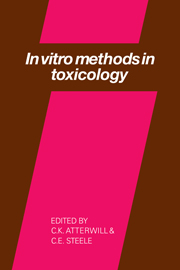Book contents
- Frontmatter
- Contents
- List of contributors
- Preface
- Introduction
- TARGET ORGAN TOXICITY
- In vitro methods in renal toxicology
- Ototoxicity
- Cultured cell models for studying problems in cardiac toxicology
- Use of the isolated rat heart for the detection of cardiotoxic agents
- Brain reaggregate cultures in neurotoxicological investigations
- Application of thryoid cell culture to the study of thyrotoxicity
- In vitro methods to investigate toxic lung disease
- Metabolism and toxicity of drugs in mammalian hepatocyte culture
- In vitro evaluation of haemic systems in toxicology
- GENERAL AND TOPICAL TOXICITY
- REPRODUCTIVE TOXICITY
- CONCLUSION
- Index
Cultured cell models for studying problems in cardiac toxicology
Published online by Cambridge University Press: 06 August 2010
- Frontmatter
- Contents
- List of contributors
- Preface
- Introduction
- TARGET ORGAN TOXICITY
- In vitro methods in renal toxicology
- Ototoxicity
- Cultured cell models for studying problems in cardiac toxicology
- Use of the isolated rat heart for the detection of cardiotoxic agents
- Brain reaggregate cultures in neurotoxicological investigations
- Application of thryoid cell culture to the study of thyrotoxicity
- In vitro methods to investigate toxic lung disease
- Metabolism and toxicity of drugs in mammalian hepatocyte culture
- In vitro evaluation of haemic systems in toxicology
- GENERAL AND TOPICAL TOXICITY
- REPRODUCTIVE TOXICITY
- CONCLUSION
- Index
Summary
INTRODUCTION
The first account of cultured heart cells was given by Burrows (1912), who concluded that the independent pulsatory activity of single cells was direct confirmation of the myogenic theory of heart muscle. On the basis of studies on cultured heart cells, Lewis (1928) rejected the concept of a branching syncytium in favor of cellular independence. Action potentials were obtained by impalement of cultured heart cells with microelectrodes (Crill et al., 1959; Fange et al., 1952; Mettler et al., 1952; Sperelakis and Lehmkuhl, 1965), and details of this methodology was given by Sperelakis (1972a). The cultured cells possess pharmacological receptors virtually identical to those of cells in the original myocardium from which they were derived. That is, use of trypsin for cell dispersal does not permanently damage the cell membrane or its receptors.
Cultured cells in monolayer networks and sheets revert back to the young embryonic state. Such reverted cells are useful for studying certain properties, such as on the mechanism of the changes in type of cation channels and in K+ permeability and on the electrogenesis of pacemaker potentials. Reverted ventricular myocardial cells may make a good model for studying the properties of cardiac nodal cells. In contrast, the cells in spherical reaggregate and strand preparations tend to retain their highly differentiated electrical properties [see book edited by Lieberman and Sano (1976) for results from several laboratories]. The reaggregates are also easier to impale with one or two microelectrodes than are the monolayers.
- Type
- Chapter
- Information
- In Vitro Methods in Toxicology , pp. 59 - 108Publisher: Cambridge University PressPrint publication year: 1987



